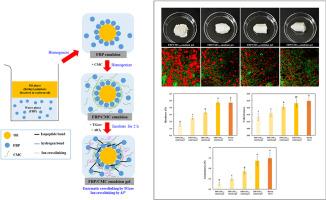Effect of carboxymethyl cellulose on structural, physicochemical, and textural properties of faba bean protein/carboxymethyl cellulose emulsion gel as a plant-based ricotta cheese analog
IF 11
1区 农林科学
Q1 CHEMISTRY, APPLIED
引用次数: 0
Abstract
The aims of this study were to develop a vitamin A-encapsulated emulsion gel and investigate the structural and physicochemical properties of the emulsion gel as a plant-based ricotta cheese analog. Emulsion gel was prepared by ionic gelation with Al3+ and enzymatic cross-linking using transglutaminase in FBP/CMC emulsion with different CMC concentrations (0.5 %, 1.0 %, 1.5 %, and 2.0 %). CLSM images showed that the oil droplets became smaller and more uniform as the CMC concentrations increased. FT-IR analysis suggested that hydrogen bonding (between CMC and FBP or between FBP molecules) was formed during the preparation of the emulsion gel. The encapsulation efficiency of vitamin A was highest in the emulsion gel with the highest CMC concentration. The solvent holding capacity tended to increase with increasing CMC concentration. In texture profile analysis, the hardness of emulsion gel increased with increasing CMC concentrations, and the emulsion gel with the highest CMC concentration showed similar hardness, cohesiveness, and gumminess as ricotta cheese. In conclusion, this study indicated that CMC could influence the structural stability of emulsion gel by allowing oil droplets to act as active fillers, and emulsion gel can be suitable as a plant-based ricotta cheese analog.

羧甲基纤维素对植物基乳清干酪类似物蚕豆蛋白/羧甲基纤维素乳凝胶结构、理化和质地特性的影响
本研究的目的是研制一种维生素a包封乳液凝胶,并研究乳液凝胶作为植物基乳清干酪类似物的结构和理化性质。以不同CMC浓度(0.5%、1.0%、1.5%、2.0%)的FBP/CMC乳液为原料,采用Al3+离子凝胶和谷氨酰胺转胺酶交联法制备乳液凝胶。CLSM图像显示,随着CMC浓度的增加,油滴变得更小、更均匀。FT-IR分析表明,在乳液凝胶的制备过程中形成了氢键(CMC与FBP之间或FBP分子之间)。在CMC浓度最高的乳液凝胶中,维生素A的包封率最高。随着CMC浓度的增加,其持溶剂能力有增大的趋势。在质构分析中,乳液凝胶的硬度随CMC浓度的增加而增加,CMC浓度最高的乳液凝胶的硬度、黏结性和胶性与乳清干酪相似。综上所述,本研究表明,CMC可以通过油滴作为活性填料影响乳化凝胶的结构稳定性,乳化凝胶可以适合作为植物性乳清干酪类似物。
本文章由计算机程序翻译,如有差异,请以英文原文为准。
求助全文
约1分钟内获得全文
求助全文
来源期刊

Food Hydrocolloids
工程技术-食品科技
CiteScore
19.90
自引率
14.00%
发文量
871
审稿时长
37 days
期刊介绍:
Food Hydrocolloids publishes original and innovative research focused on the characterization, functional properties, and applications of hydrocolloid materials used in food products. These hydrocolloids, defined as polysaccharides and proteins of commercial importance, are added to control aspects such as texture, stability, rheology, and sensory properties. The research's primary emphasis should be on the hydrocolloids themselves, with thorough descriptions of their source, nature, and physicochemical characteristics. Manuscripts are expected to clearly outline specific aims and objectives, include a fundamental discussion of research findings at the molecular level, and address the significance of the results. Studies on hydrocolloids in complex formulations should concentrate on their overall properties and mechanisms of action, while simple formulation development studies may not be considered for publication.
The main areas of interest are:
-Chemical and physicochemical characterisation
Thermal properties including glass transitions and conformational changes-
Rheological properties including viscosity, viscoelastic properties and gelation behaviour-
The influence on organoleptic properties-
Interfacial properties including stabilisation of dispersions, emulsions and foams-
Film forming properties with application to edible films and active packaging-
Encapsulation and controlled release of active compounds-
The influence on health including their role as dietary fibre-
Manipulation of hydrocolloid structure and functionality through chemical, biochemical and physical processes-
New hydrocolloids and hydrocolloid sources of commercial potential.
The Journal also publishes Review articles that provide an overview of the latest developments in topics of specific interest to researchers in this field of activity.
 求助内容:
求助内容: 应助结果提醒方式:
应助结果提醒方式:


